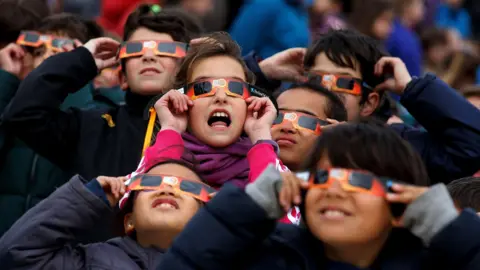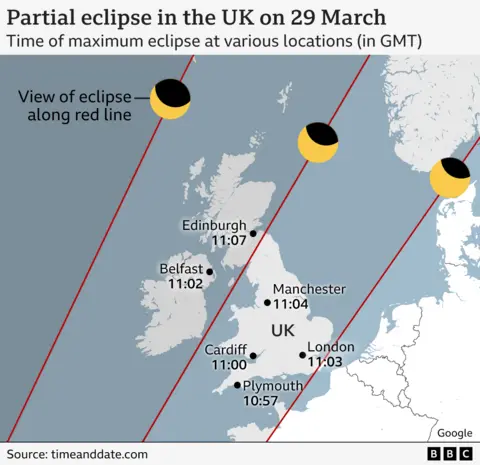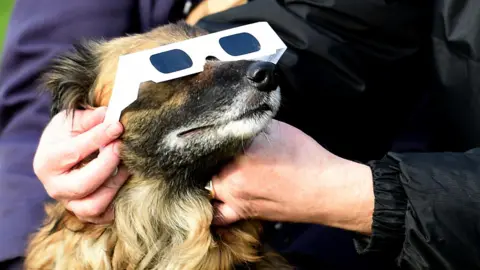How to watch the partial solar eclipse

BBC climate and science
 Getty Images
Getty ImagesPrepare your protective eclipse glasses – you can see that the moon receives a “bite” from the sun this morning by allowing the air.
Partial solar eclipse will be seen throughout England. People will have the chance to see the lid of the moon with the best chance of the best open sky in Southeast England, East Anglia and Midlands.
The eclipse will not be total anywhere in the world, but the northeastern regions of Canada will see 92% of the sun.
You should not look at the sun directly because it may damage your eyes seriously, so if you take a look, you will need these special eclipses.
When and where will the partial eclipse be seen?

This partial eclipse will be seen by visible levels in Europe, Northwest Africa, Greenland, Iceland and Northeast USA and Eastern Canada.
It will start at 10:07 in England and end in the middle of noon.
Some parts of the UK will see the sun’s gate more than others. For example, if you are in the outer Hebrides, you will see that the sun is hidden up to 47%, you will see that only 28% of the dover in Southeast England are covered.
The eclipse times will change slightly depending on where you are, so use it Clock and Date To check the exact times in your position.
“This is an excellent chance to go out, look safely and see the movement of the solar system yourself.” He said.
“It’s a great way to just connect to everything that’s and see them all in motion.”
What is solar eclipse?

When the moon moves between the sun and the soil, a solar eclipse occurs when it prevents a part or all of the sunlight.
There are different types of solar eclipses depending on how much of the sun is hidden.
- Partial solar eclipse-Moon of the Sun partially and leaves a crescent-shaped part of the sun visible.
- The ring -shaped solar eclipse – the moon is directly in front of the sun, but looks smaller and leaves a thin, bright sunlight around the edges.
- Total Solar Eclipse – Moon completely covers the sun and reveals a shining outer atmosphere called Corona.
When and where the next solar eclipse?
Skywatchers in the UK will be treated with another partial solar eclipse on August 12, 2026, Eastern Greenland, Iceland and North Spain will experience a more rare total eclipse.
England will not witness the full solar eclipse for 65 years until 23 September 2090 According to the Royal Observatory in Greenwich.
England’s last total solar eclipse took place in 1999Cornwall is the only place in the country that experiences the event in the integrity and attracts thousands of people to the region.
How to safely monitor a solar eclipse
 Getty Images
Getty ImagesIt is important to make sure that you take appropriate measures to view this event safely.
Even during a partial eclipse, it is never safe to look at the direct sun with the naked eye, as it may cause eye damage, including blindness.
The solar eclipse glasses are specially designed to filter harmful UV rays and reduce the intense brightness of the sun, which makes it safe to look at the eclipse directly.
Normal sunglasses do not work because they do not prevent enough light to protect your eyes from the extreme density of the sun.
“If you block sunlight with your Eclipse glasses with your sunglasses, you can’t see where you are going!” Mrs. Gammon-Ros said.
If you do not have access to Eclipse glasses, you can only create a simple needle hole camera with two leaf cardboard, or even use a colander to safely reflect the image of the sun to the ground.
Local astronomical societies can host eclipse activities with telescopes equipped with solar filters.
The Royal Observatory in Greenwich will host a vibrant flow of March 2025 Solar Eclipse and allow audiences throughout England to experience online in real time.
Looking at the sun without protection can cause permanent retinal damage and blindness even after exposure to only a few seconds.
Will the sky be open enough to see?
On Saturday morning, the weather can be a bit difficult for some, and the chance of seeing the eclipse changes significantly depending on where you are in the UK.
The best in the open sky can be found in Southeast England, East Anglia and Midlands. A little high cloud is possible, but it should not break this appearance too much.
Luck in Wales and in the northern and western regions of the UK is slightly lower. Although there are some clear spells, the amount of clouds is expected to increase in the morning.
The air will be problematic for Sky Gazers in Scotland and Northern Ireland, especially with thick clouds and rain outbreaks in the North and West.
I Rich, additional reports by BBC Weather





